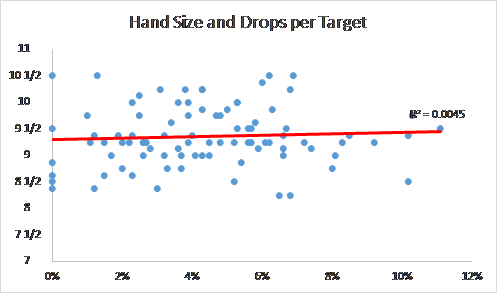The NFL Scouting Combine marks the true flash point of dynasty league rookie euphoria. While the Combine is necessary to create a full NFL Draft prospect composite profile, it also clouds and distracts dynasty league enthusiasts from the more predictive data points, such as College Dominator Rating and Breakout Age illustrated by the WR Prospect Regression Tree. Remember Keith Marshall’s speed score-propelled rookie draft ADP rise!
The fun starts with the Day 1 spandex procession, which is the one time each year I need to remember how to convert decimals into 1/8 increments so my Twitter timeline makes sense. The instant analysis on hand size, arm length, and wingspan is like a measurables firehose. Hand size, in particular, garners significant attention social media attention. Player X has monster mitts!
Kenny Lawler and Marquez North’s hand/wingspan sizes stand out the most to me out of the WR group
— pat (@WizardsNation) February 25, 2016
Fortunately, PlayerProfiler’s Data Analysis Tool allowed me to get out ahead of the data stream to better understand which measurables matter more than others. Specifically, how much does hand size matter? I then analyzed hand size’s correlation to the following efficient metrics:
- Contested Catch Rate.
- Catch Rates
- Red Zone Catch Rate
- Drop Rate
- Yards Per Target
Intuitively, I had always assumed that larger hands improve a wide receiver’s contested catch conversion rate. Big hands should provide an advantage when battling with corners. The top of the list did not provide evidence to support the hypothesis. Note: the sample for this examination only included players with both available hand size data and requisite targets to qualify.

Top Contested Catch Performers in 2016
Hand Size and Catch Rate
Running a basic regression analysis also confirmed slight, insignificant correlation.
The R squared coefficient illustrates no meaningful relationship between hand size and contested catch rate. A similar hand size regression test versus catch rate and red zone catch rate yielded little to no meaningful relationship. Hand size zealots were likely hoping for a more than a slight, yet negligible, correlation between hand size and catch rate.
Hand Size and Drops
After observing little correlation between hand size and various catch rate iterations, I tested how hand size effects drop rate and yards per target. Intuitively, hand size should reduce wide receiver drop rate. However, after contested catch rate did not correlate to hand size, it seemed unlikely that drop rate would correlate. The analysis demonstrated negligible relationship between hand size and drops.
Hand Size and Yards Per Target
Yards per target was the last hope for a meaningful regression, but alas, the analysis demonstrated no correlation with hand size.
While a single skeleton key metric predicting future WR success does not exist, we can use the vast data in the PlayerProfiler database to create a a composite player profile, a fuller picture for fantasy gamers to better identify rookie sleepers and busts. This exercise shows that for all of the helpful data points that the NFL Scouting Combine delivers, many measurables simply do not matter. For wide receivers, hand size is irrelevant.







